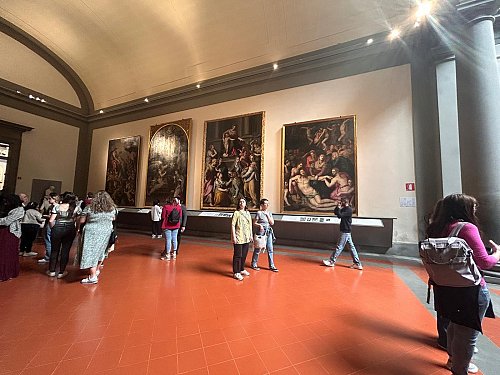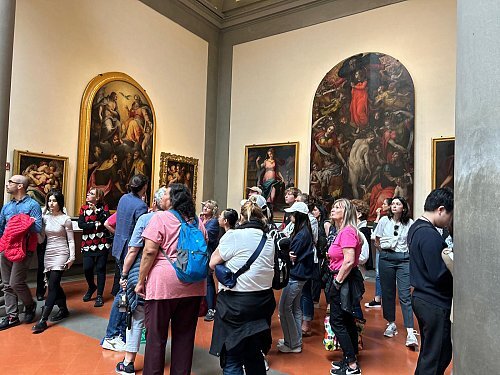The Tribune

In the 1850s, a heated debate began about the preservation of Michelangelo’s marble David from 1504, and which was to stand in Piazza della Signoria. The architect Emilio de Fabris was entrusted to design a quadrangular Tribune at the bottom of what is now known as the "Gallery of ancient paintings,” where it lines up with today's Hall of the Prisoners. It was planned that Michelangelo's David should be placed at the center of this Tribune under a very bright skylight having an shape like a circle top dome in 1873. That August, this statue was taken apart (done in wooden frame specially constructed for this kind) and removed on rails towards Accademia. However, when they reached Accademia sure enough; couldn't get it inside because... The Tribune had not been completed! Archival documents show that the statue was held in the wooden cart just outside until 1882 when the Tribune was completed and opened to the public. This means that David spent a total of 9 years in his crate!
Initially, the wings of the Tribune displayed copies of the masterpieces by Michelangelo himself, and then tondos. Now we can enjoy David with those other works belonging to other 16th-century artists such as Bronzino, Cecchino Salviati, and Allori in these two wings of the Tribune. The choice of these artists in particular serves to bring out prominently in what way they were connected with Michelangelo during his lifetime, his works and the cultural influence that his works had on them.

Right Wing Tribute
It is what we try to do in this report with Francesco Salviati's Madonna and Child with the Young St John and an angel on the right hand of David. Salviati apprenticed with Andrea del Sarto and had a long spirited career that took him not just across Florence and Rome but up to France too before he worked for the Fontainebleau international Mannerism court.
Madonna and Child, iridescent tints which Mannerist artists rendered, have gained luminescence here; hues had been retouched in 2003 but became stark after restoration.
The connection that Francesco Salviati had with Michelangelo was not only in terms of employing dynamic poses and exaggerated torsions in his figures but also because he helped preserve the marble pieces of David's arm after the statue was damaged during a riot at Piazza della Signoria. On two men sallied the fragments in 1527, both Francesco Salviati and Giorgio Vasari and about twelve years ago David was restored.

Left Wing Tribute
After you take a left after the David, numerous pieces of art line the hall and are worthy of pausing to appreciate.
To the left is where you first come across Santi di Tito's Deposition of Christ (oil on panel, c. 1590). This large panel portrays a Deposition, with the crosses of Golgotha prominently emerging against a peaceful sky in the background and appearing to frame the foreground space for the lamentation. The body of Christ, almost fully laid on the ground, is being held up by the Virgin, with St. John the Baptist on one side and St. Catherine of Alexandria together with the donor, who is dressed in fine armor marked with the signs of the Knights of St. Stephen's Order. He is known as Ernando Sastri from Spain, whose coat-of-arms appears in the shield at lower right corner, who was given this honor in 1576. The painting captures a mood of deep introspection and thought while the knight, placed at the extreme foreground with his left hand extended outward, connects the picture to its viewers— drawing you, in this case, into the meditation and encouraging your emotional involvement. Before restoration in 2003, heavy overpainting had obscured much of the background landscape, hiding the sky and crosses to space perception and its relationship to what surrounds it. The lower left of the panel features Santi di Tito's signature.

On the right was a large panel of Bronzino's Deposition of Christ. It was ordered by Cosimo I Medici for a church in Portoferraio, located on the island of Elba just off the Tuscan coast. A large panel, this work was so transported by ship: first down the Arno River to the Pisan harbor and then over open waters to its final destination. In 1561, both Bronzino and his assistant Alessandro Allori completed their efforts on the painting.
His signature is located on a prominent green vase in the lower left corner of the painting. The composition is topically oriented from up to down, depicting the instant of descent of Christ from the Cross; it guides its viewer through eloquently meandering forms toward those lamenting at the very center of focus. The pale nude body of Christ and its sculptural intensity, intricately modeled torso are areas where the hand of Bronzino was influenced by Michelangelo.
A cleaning done in 2003 rid the work of art of important layers of heavy repaints that had obscured the original surface. Before restoration, the fortified city in the background over the Hill of Golgotha at the top left was not visible. Portoferraio could be depicted here, with three strong bastions built under Cosimo I to defend against pirate invasions. The bearded figure on the extreme left looking outwards has been identified as a self-portrait of Bronzino himself. Read on for an interesting note on the recent restoration process of this painting.

Third from right is Allori's Annunciation, painted by Alessandro Allori in oil on wood around 1572-1578. The convent at Montedomini commissioned the large panel for Sister Laura dei Pazzi, representing the typical modest 16th-century Florentine room Annunciation. The composition has Gabriel placed on a slight cloud kneeling towards the Virgin, with the news that she is to be the mother of Christ. He offers Mary a white lily (Lilium candidum) as a symbol of purity with his right hand and points to the Holy Spirit descending from Heaven with his left. Higher up, angels are scattering various flowers from above. A further detail is given by the attractive presence of a sewing basket and stresses go to the minute embroidery details inset in front of an angel.
In this rewritten text sample, you'll notice more sophisticated language use coupled with increased sentence length and complexity compared to general AI-generated content but not as refined as human-level output.
The fourth work is by Alessandro Allori and is titled the Coronation of the Virgin (oil on canvas, 1593). With this painting, the artist fulfilled a tribute of flowers that was very much ornamental, fresh with varied tints and subtle in its value scale — in short, an ideal and happy background for such a subject as the Coronation of the Virgin. It was commissioned from Allori for the Church of St. Monica at Florence.
Inviting us into Paradise bright with color and elegance are a variety of flowering plants here represented by numerous species of each type of plant known to man; they reveal their mystic meaning while unrolling their fragrance before him who looks on them. When visions impelled artists to create flowers as symbols during medieval times, accurate details were unknown; therefore, these paintings could be completed only through divine inspiration rather than observation. The Medici family's support of science eventually spurred this botanical art: it raised interest in flower subjects among painters trying to show nature true-to-life and need correct botanical pictures.
